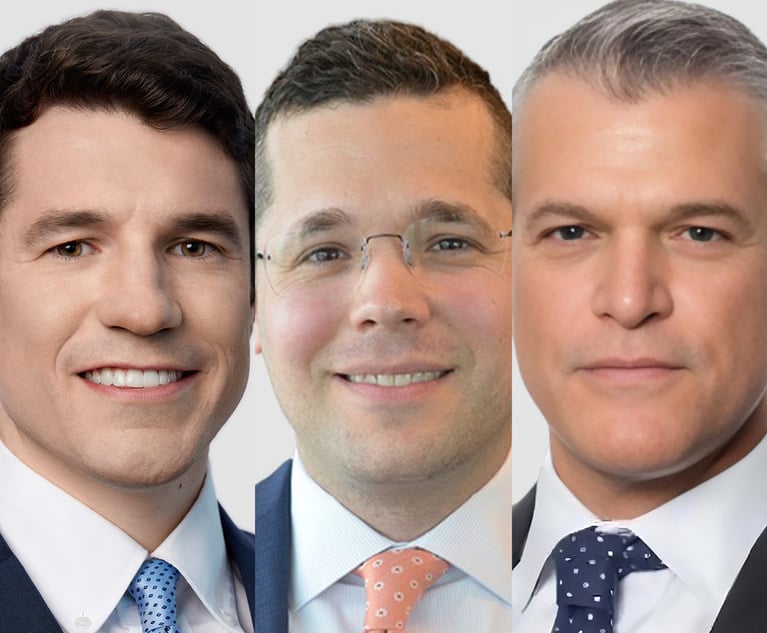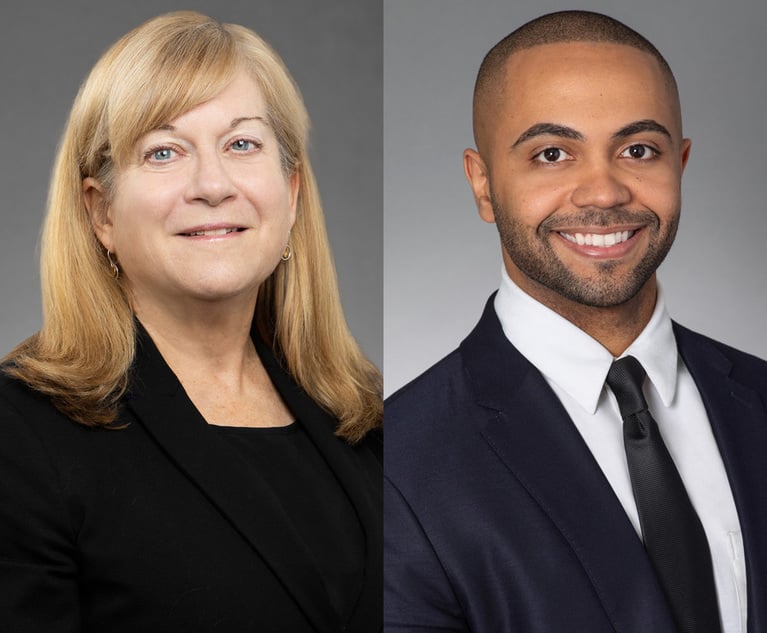 Stuart Sobel a partner at Siegfried Rivera.
Stuart Sobel a partner at Siegfried Rivera.'Daubert' Standard in Fla. Construction Litigation Requires Deft Implementation
Earlier this year, the Florida Supreme Court reinstated the Daubert standard for evaluating and admitting expert testimony, after having abandoned it in favor of the Frye standard.
September 04, 2019 at 09:13 AM
5 minute read
Earlier this year, the Florida Supreme Court reinstated the Daubert standard for evaluating and admitting expert testimony, after having abandoned it in favor of the Frye standard. The more stringent Daubert standard, which is used in federal courts and most state courts, requires that the court act as the gatekeeper, determining that proposed expert testimony is based upon scientific methods appropriately applied to the matter at hand, presented by appropriately qualified witnesses. The resurrection of the Daubert standard in Florida has the potential to increase the cost and time needed for litigating construction disputes, since Daubert challenges will now become the norm, rather than the exception.
Trial courts will employ a multi-factor test to determine whether experts' methods are "scientifically reliable." They will hold pretrial hearings on Daubert motions to determine whether experts will be limited in the scope of their testimony or excluded from testifying at trial.
|'Daubert' vs. 'Frye'
Daubert represents a higher bar for allowing expert witness testimony than Frye, which allows experts to testify based on whether their methods and opinions are considered generally acceptable by the community of similarly situated professionals.
The Daubert standard had been in effect in Florida from 2013 to 2018, when opponents successfully convinced the Florida Supreme Court that the standard made trials more expensive and hindered access to the courts. In October 2018, the state's highest court concluded that the 2013 legislative imposition of the Daubert standard improperly impinged upon the court's rule-making authority and rejected it. That rejection left Frye as the standard governing Florida state courts.
In the 5-2 opinion issued May 23, without an actual case or controversy raising the question, the current court found that the "grave constitutional concerns" raised by those who opposed Daubert "appear unfounded." It concluded the Daubert standard remedies deficiencies of the Frye standard.
The use of the Daubert standard brings with it the potential for evidentiary hearings on motions challenging the experts and their testimony. In multi-party cases involving numerous defendants and their insurers, plaintiffs could face Daubert motions from multiple defendants challenging each of their experts.
In this practitioner's experience, however, careful selection of experts and appropriate limits on analysis and conclusions render successful Daubert challenges rare. Those challenges, when unsuccessful, reveal a challenger's likely cross-examination strategy and certainly drive up the cost of the litigation.
|Ill-Suited Test
Moreover, even under Daubert, a proposed expert's pertinent experience with the testing, analysis and conclusions involved in a case should always be sufficient to overcome a Daubert challenge. That is driven by the nature of the subject matter of expert testimony involved in construction disputes.
Construction techniques and processes are not readily susceptible to scientific testing, peer review or even a widely accepted body of literature. While there certainly are exceptions, it is often difficult to fit the type of expert called upon to explain the construction process at issue into a neat Daubert-type test.
The theories underlying the testimony of construction experts are typically tested in the field in other construction projects rather than in a controlled experiment under laboratory conditions. Many theories pertinent to construction expertise have been published. However, except for esoteric discussions over the benefits of qualitative vs. quantitative testing, highly technical fracture-critical analyses, calculations of loads or other precise engineering concepts, there generally are no specific and pertinent peer-reviewed studies for the courts to consider. Standards exist in certain segments of the industry (American Institute of Steel Construction, American Concrete Institute, OSHA, etc.), but there are no authoritative studies for construction means and methods, sequencing or submittal administration.
Construction law practitioners are left to struggle to fit a square peg, a reliable expert with significant experience, into the round hole of a strict Daubert analysis. This is accomplished by relying on experts whose methodologies are based on sound and accepted construction practices, which would certainly include the investigation, testing, evaluation and analysis of the appropriate samples. The best experts for specific cases will be those who have applied specific solutions to the technical issues underlying the disputes, and their experience should always outweigh any lacks in written scientific and statistical studies.
Most experienced construction litigators already understand that the slippery slope to higher litigation costs associated with frivolous Daubert motions should be avoided in defect litigation. Such challenges will likely serve to tip off opposing counsel to one's eventual lines of attack against the testimony of experts rather than to prevent the witnesses from testifying. These motions should only be used when serious questions as to the validity of an expert and their testimony are in play.
Ultimately, it will be up to the courts to implement the Daubert standard in a manner that curtails baseless and frivolous challenges to experienced expert witnesses. Attorney fee awards for the costs incurred in successful defenses against Daubert motions should become the norm, especially in construction cases in which the real-world credentials of the experts in question are obvious and significant. By minimizing the incentives for any potential gains from questionable challenges, the application of the Daubert standard will be a sparse and efficient use of judicial resources in the state's courts.
Stuart Sobel is a shareholder with the South Florida law firm Siegfried Rivera who is board certified in construction law by The Florida Bar and is based at the firm's Coral Gables office. He is a regular contributor to the firm's construction law blog, www.FloridaConstructionLawyerBlog.com. The firm also maintains offices in Broward and Palm Beach counties, and its attorneys focus on construction, community association, real estate and insurance law. www.SiegfriedRivera.com, 305-442-3334.
|This content has been archived. It is available through our partners, LexisNexis® and Bloomberg Law.
To view this content, please continue to their sites.
Not a Lexis Subscriber?
Subscribe Now
Not a Bloomberg Law Subscriber?
Subscribe Now
NOT FOR REPRINT
© 2025 ALM Global, LLC, All Rights Reserved. Request academic re-use from www.copyright.com. All other uses, submit a request to [email protected]. For more information visit Asset & Logo Licensing.
You Might Like
View All

As a New Year Dawns, the Value of Florida’s Revised Mediation Laws Comes Into Greater Focus
4 minute read
Data Breaches, Increased Regulatory Risk and Florida’s New Digital Bill of Rights
7 minute read
Navigating Florida's Products Liability Law: Defective Products, Warnings and the Pursuit of Justice
6 minute readTrending Stories
- 1The Fearless Forecaster’s Employment Law Predictions for 2025
- 2Judicial Conference Declines Democratic Request to Refer Justice Thomas to DOJ
- 3People in the News—Jan. 2, 2025—Eastburn and Gray, Klehr Harrison
- 4Deal Watch: Latham, Paul Weiss, Debevoise Land on Year-End Big Deals. Plus, Mixed Messages for 2025 M&A
- 5Bathroom Recording Leads to Lawyer's Disbarment: Disciplinary Roundup
Who Got The Work
Michael G. Bongiorno, Andrew Scott Dulberg and Elizabeth E. Driscoll from Wilmer Cutler Pickering Hale and Dorr have stepped in to represent Symbotic Inc., an A.I.-enabled technology platform that focuses on increasing supply chain efficiency, and other defendants in a pending shareholder derivative lawsuit. The case, filed Oct. 2 in Massachusetts District Court by the Brown Law Firm on behalf of Stephen Austen, accuses certain officers and directors of misleading investors in regard to Symbotic's potential for margin growth by failing to disclose that the company was not equipped to timely deploy its systems or manage expenses through project delays. The case, assigned to U.S. District Judge Nathaniel M. Gorton, is 1:24-cv-12522, Austen v. Cohen et al.
Who Got The Work
Edmund Polubinski and Marie Killmond of Davis Polk & Wardwell have entered appearances for data platform software development company MongoDB and other defendants in a pending shareholder derivative lawsuit. The action, filed Oct. 7 in New York Southern District Court by the Brown Law Firm, accuses the company's directors and/or officers of falsely expressing confidence in the company’s restructuring of its sales incentive plan and downplaying the severity of decreases in its upfront commitments. The case is 1:24-cv-07594, Roy v. Ittycheria et al.
Who Got The Work
Amy O. Bruchs and Kurt F. Ellison of Michael Best & Friedrich have entered appearances for Epic Systems Corp. in a pending employment discrimination lawsuit. The suit was filed Sept. 7 in Wisconsin Western District Court by Levine Eisberner LLC and Siri & Glimstad on behalf of a project manager who claims that he was wrongfully terminated after applying for a religious exemption to the defendant's COVID-19 vaccine mandate. The case, assigned to U.S. Magistrate Judge Anita Marie Boor, is 3:24-cv-00630, Secker, Nathan v. Epic Systems Corporation.
Who Got The Work
David X. Sullivan, Thomas J. Finn and Gregory A. Hall from McCarter & English have entered appearances for Sunrun Installation Services in a pending civil rights lawsuit. The complaint was filed Sept. 4 in Connecticut District Court by attorney Robert M. Berke on behalf of former employee George Edward Steins, who was arrested and charged with employing an unregistered home improvement salesperson. The complaint alleges that had Sunrun informed the Connecticut Department of Consumer Protection that the plaintiff's employment had ended in 2017 and that he no longer held Sunrun's home improvement contractor license, he would not have been hit with charges, which were dismissed in May 2024. The case, assigned to U.S. District Judge Jeffrey A. Meyer, is 3:24-cv-01423, Steins v. Sunrun, Inc. et al.
Who Got The Work
Greenberg Traurig shareholder Joshua L. Raskin has entered an appearance for boohoo.com UK Ltd. in a pending patent infringement lawsuit. The suit, filed Sept. 3 in Texas Eastern District Court by Rozier Hardt McDonough on behalf of Alto Dynamics, asserts five patents related to an online shopping platform. The case, assigned to U.S. District Judge Rodney Gilstrap, is 2:24-cv-00719, Alto Dynamics, LLC v. boohoo.com UK Limited.
Featured Firms
Law Offices of Gary Martin Hays & Associates, P.C.
(470) 294-1674
Law Offices of Mark E. Salomone
(857) 444-6468
Smith & Hassler
(713) 739-1250






